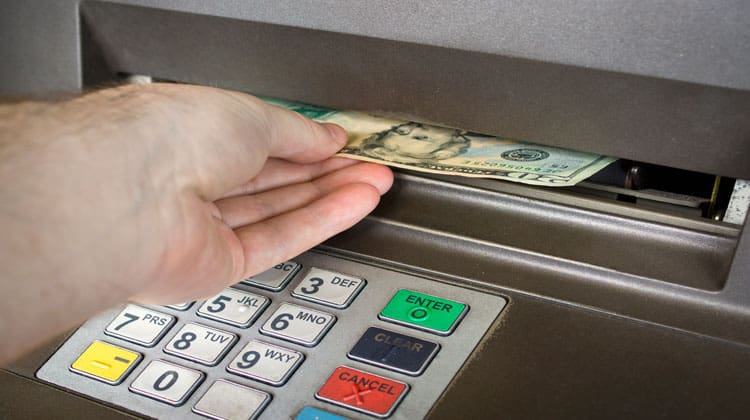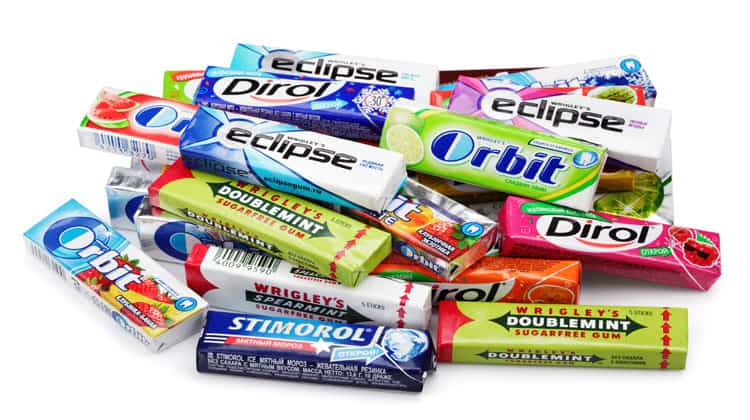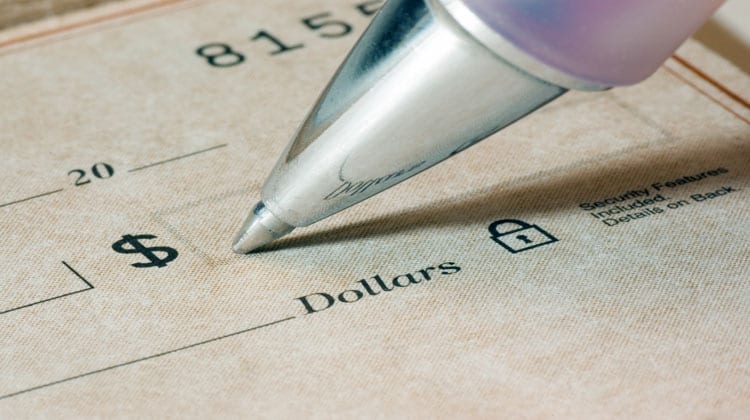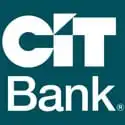THIS POST MAY CONTAIN AFFILIATE LINKS. PLEASE SEE MY DISCLOSURES. FOR MORE INFORMATION.
It’s become all too common to pay fees when accessing an automated teller machine. In some cases, these fees can be 40% of the money you are withdrawing.
And if you frequently use the ATM machine to get cash, you are spending a lot of money on unnecessary fees.
Luckily, with a little planning, you can completely avoid ATM fees.
In this post, I share with you the best tips for how to avoid ATM fees and keep more of your money.
The bonus is these tips are simple to use, so you won’t be spending a lot of time or energy to save the money.
Table of Contents
13 Tips For How To Avoid ATM Fees
#1. Look For ATMs In Your Bank’s Network

Whenever you’re going to pull cash from your checking account, the easiest way to save on fees is to go to an ATM belonging to your bank first.
These ATMs are not going to charge you a fee for using them.
Generally speaking, most people also have ATMs fairly close to them, whether they’re solitary ATMs or ATMs attached to a local branch, that they can take advantage of.
To make finding these easy, head over to your banks website and they should have a section where you can put in your address or the zip code and a map will show you in network ATM machines.
After you do this once or twice, you will remember where you can access your cash without a fee.
And if you are going some place new, make sure you take 5 minutes to look at the map for that area so you know where to stop in case you need the cash.
#2. Look For Non-Branded Partner ATMs
What many consumers may not know is that there are actually some non-branded ATMs that won’t charge you a fee for using them either.
These types of ATMs that are in-network will vary from bank to bank.
To know what network your ATM card is, look on the back and you will see the network logo.
For example, a popular one is the STAR network.
This means you can use any STAR branded ATM network machine and not worry about paying a fee.
And to find these ATM machines, simply follow the tip above for looking at a map online.
You can either go to your banks website again as they will show you these non-branded ATMs or you can simply do an online search, like for STAR network ATM near me for a list.
#3. Find Fee-Free ATMs
There aren’t a lot of places that offer fee-free options, but it is worth a look at an ATM locator to see if there are any in your area.
These are ATMs usually at a convenience store or grocery store that does not charge any fees, regardless if you are in network or not.
The store offers this benefit because they know people will come in just to withdraw money.
And chances are when they are there, they might buy something too.
#4. Make A Small Purchase At The Store

If you’re heading over to your local supermarket at some point during the day, you could always skip the ATM and get cash back instead.
These services don’t come with fees and they’re easy to use.
All you have to do is insert your card when you go to pay for your groceries, ask for cash back on the screen, and get the amount you need for the rest of the day or night.
This also works at convenience stores and the gas station too.
Basically any place that accepts debit cards, you have the option for cash back.
- Read now: Learn the pros and cons of debit cards
This is what I did back in college.
There were no ATMs around that didn’t charge a fee and since money was tight, I wasn’t OK with paying the fee.
So I would go to the drugstore down the street, buy what I needed, and then requested cash back.
The only catch to this option is if you go late at night and need a large amount of cash.
Many places limit the amount of money in the cash register for security reasons.
So while you could get $20 cash back, chances are you might not be able to get $100.
Also, don’t make the mistake of just rushing in an buying a pack of gum or a candy bar if you have no interest in it.
When you do this, you are still paying the fee, the difference is you have a pack of gum now.
Either way, it is wasted money.
Take a few minutes to find something you need and you avoid the fee entirely.
#5. Find Alternatives To Using Cash
In today’s world, cash is becoming relatively obsolete.
As a result, you have far more payment options at your disposal.
One way you can ditch ATM fees is to use digital payments.
Most smartphones have a wallet app installed where you can insert your card information directly into your digital wallet.
Much like how a chip reader works, you can then bring your phone close to a card reader to make a payment.
While not all places necessarily have a POS system that will allow them to read these, the majority do.
This makes it possible for you to just bring your phone wherever you go and avoid carrying cards or cash entirely.
#6. Use Digital Payment Apps
If you are going out for the night with friends but don’t have cash, you might not need to make a quick stop at the ATM.
Digital payment apps like Venmo make it easy to transfer money to another person.
Your friend then has the option to deposit the money into their bank account, or keep it in the digital payment app to pay for something or someone else.
- Read now: See the difference between checking and savings accounts
- Read now: Learn how to say no to family asking for money
There are a lot of these apps popping up, here are the most common ones you will run into.
- Venmo
- Zelle
- PayPal
- Google Pay
- Cash App
- Meta Messenger
- Apple Pay
Chances are there is a mobile app you and your friend uses to make transferring money quick and easy.
#7. Cash Your Check At The Bank
While a checking account is aptly named because you can make transactions using checks, checks aren’t as widely used as they once were.
That being said, these are still helpful tools to help you access your funds when you do need them.
If you have a checkbook sitting around, all you have to do is fill it out to yourself or to cash and go to your bank to cash it.
- Read now: Find out how to write a personal check to yourself
- Read now: Here is how to write a check in less than a minute
Just make sure that you use that check immediately and avoid carrying it around with you wherever you go.
If someone should get their hands on your check, they can easily cash it themselves, and you’ll have to go through the trouble of calling your bank to reverse that transaction before it goes through.
#8. Cash Your Check Where Personal Checks Are Accepted

The downside to the tip above is that most banks close by 5pm during the week and are not open on the weekends.
If you need money during non-banking hours, what are you to do?
The answer is to find other places that cash personal checks.
Many grocery stores, drug stores, and convenience stores will cash a personal check.
Just make sure you bring some personal identification with you.
If you go this route, it is important to call ahead to make sure the check cashing store doesn’t charge a fee, otherwise you are in the same situation as if you used your ATM card at an out of network ATM machine.
#9. Use Withdrawal Slips
Are you currently out of checks or you don’t happen to have checks at home?
Not all hope is lost.
Simply use a withdrawal slip to take money out of your checking or savings account.
Withdrawal slips allow you to pull funds out of your account by providing your bank with the account information that you want to make a withdrawal from.
If you have an online banking app or you happen to have your banking paperwork around the house, you can find your account number and your routing number here.
Then, all that’s left to do is fill it out, bring it to a teller, and get your funds without having to deal with any pesky fees.
If you need any help, your bank would be more than happy to find ways to help you get cash from your account.
#10. Buy Reloadable Gift Cards
While most gift cards out there are for a set amount and then become worthless, there are reloadable cards out there.
With these, you buy the card load the amount of money you want on it.
When your balance gets low, you can reload more money onto the card.
This is a great backup solution. Keep $100 on the card and keep it in your wallet for when you might need it.
#11. Keep Cash On You
Another great idea is to always have cash on you.
Simply get $40 and keep $20 in your wallet or purse.
Ideally, you won’t put this where you usually keep money as you will be tempted to spend it.
Rather this money is for random times when you don’t have cash and would rather not run to the ATM.
Fold it up and put it in another part of your wallet.
For the other $20, hide it in your car.
Then when the situation arises where you need the cash, you have it.
#12. Switch Banks
This option is for those who find there are very limited number of in network ATMs in their area.
You might be best served by switching banks.
Look at other banks or credit unions in your area as they might have more bank branches and ATM machines for you to make an ATM withdrawal from.
When doing this, think twice about smaller banks.
There might not be a lot of ATMs in the bank’s network, wasting your time for switching.
You can even look at online banks too.
With one of the highest paying interest rates in the U.S. CIT Bank stands out as the best high yield savings account. Add in ease of use and great customer service, and you have a clear winner.
Many of these banks do not charge fees for a cash withdrawal and if the ATM owner charges a fee, your bank will reimburse the fee.
Here are some banks to look into.
Finally, before you decide to switch to a new bank, it’s a good idea to call your own bank.
They might offer a bank account that also offers ATM fee reimbursements, and might even waive monthly maintenance fees too.
There is a lot of competition in the banking industry and it is a lot cheaper to keep a current customer than it is to find a new one.
So before you leave, see if there is anything your current bank offers.
#13. Consider Spending Crypto
Cryptocurrency or digital currency has become wildly popular in recent years.
Assets like Bitcoin have managed to make their way into the public eye, and their prices have skyrocketed in a matter of months.
But while some may see digital assets as investments, others may be holding onto them to use for actual transactions.
Some people may even get paid in their crypto of choice.
Let’s imagine that you have some crypto in an exchange or you have a digital wallet app on your phone.
If you go to places where crypto is accepted, you can spend your crypto like cash.
If you have an exchange that offers debit cards, you can always use these tools to spend crypto by converting it immediately to cash so that the vendor will accept it.
It’s important to note that there are such things as Bitcoin ATMs.
If you’re someone who doesn’t mind paying a little more to get cash out of these because it’s not money you rely on for monthly expenses, you could always look for one near you and turn your Bitcoin into cash so that you don’t have to dip into the funds in your checking account.
However, they’re by no means a way to avoid fees.
One of the fees that you’re going to pay for getting your cash is the network fee.
These are relatively small in comparison, but they’re still necessary if you want to make transactions.
Bitcoin ATM fees, on the other hand, can be much more substantial, which isn’t helpful if you’re looking to avoid ATM fees.
At the lowest, you may be able to find a Bitcoin ATM that only charges you 6.5% per transaction.
However, the average is typically between 10% – 20%.
Some Bitcoin ATMs may even go as high as 25%.
This isn’t an issue for everyone, but you should know that there are a lot of hidden costs to these types of ATMs that you wouldn’t otherwise pay with ATMs that disburse local currency.
Final Thoughts
There are the best ways for how to avoid ATM fees.
As you can see, the processing of avoiding these ATM surcharges is easy, you just have to do a little planning ahead of time.
And while you might not be that interested in doing the work, it is more than worth it.
With the average ATM fee coming in at $3, if you make three ATM transactions a month, you are paying over $100 in fees.
You work hard for that money, so don’t just give it the big banks.
Figure out a solution that works for you that allows you to keep your own money.
- Read now: Learn how to save $100K fast
- Read now: Find out the best tips for building wealth
- Read now: Here are the best Ted Talks about personal finance
I have over 15 years experience in the financial services industry and 20 years investing in the stock market. I have both my undergrad and graduate degrees in Finance, and am FINRA Series 65 licensed and have a Certificate in Financial Planning.
Visit my About Me page to learn more about me and why I am your trusted personal finance expert.


